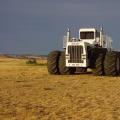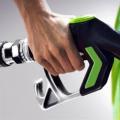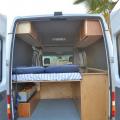For more than 15 years, many drivers have chosen Bridgestone Blizzak tires to be able to drive safely in the most challenging conditions of the winter months - on slush, slush or ice-covered roads - so that the Blizzak brand has become synonymous with safety and confidence for drivers during the challenging winter season.
But technical progress, as you know, does not stand still, so in order to further enhance grip on snow and ice Bridgestone has developed a new winter Blizzak WS70 designed for passenger cars, minivans and crossovers. Since the novelty was presented to tire dealers and journalists before a wide audience, Tire Rack experts had the opportunity to test them in Steamboat Springs (Colorado, USA).
Tests have begun at the local ice rink, which allows you to perfectly simulate driving on smooth ice often seen at slippery intersections. The first task was to accelerate from standstill to 16 km / h. To do this, two identical 2010 Toyota V6 Camry tires were fitted with Bridgestone Blizzak WS70 and Michelin X-Ice Xi2 tires. Traction control was left on to assist the driver if the wheels begin to slip. All tires were run-in before testing. smooth roads(approximately 10,000 km).
Michelin was tested first. When starting from a standstill, it was required to very carefully increase the speed so that the traction control system did not immediately turn on. The same accuracy was required during the entire race up to 16 km / h to avoid additional wheel spin. Now Bridgestone. Experts noted that these tires started without noticeable slippage, and felt like they were able to accelerate faster than the Michelin. So much so that it was possible to effortlessly exceed the intended speed of 16 km / h.
Upon reaching a constant speed of 16 km / h, the pilots applied the brakes sharply to stop the car using ABS. To determine the speed of the Camry and the length of the braking distance, special equipment Vericom VC2000 was used. Braking distances The Bridgestone was about 0.6m shorter than the Michelin.
For the final visual demonstration, both tires were installed on the car - on the left side of Bridgestone, on the right side of Michelin. ABS was disabled so that all wheels could lock during hard braking. The idea was that tires with higher grip would decelerate their side of their car faster, causing the drive to deflect towards the more grippy tires. During acceleration, the pilot sharply pressed the gas pedal and, as expected, the Camry took off to the left, i.e. Bridgestone has proven its superiority.
Snow
After that, the Tire Rack team went to school winter driving Bridgestone, where they were already waiting for two more Toyota V6 Camry 2010, "shod" in Bridgestone Blizzak WS70 and Michelin X-Ice Xi2 (both sets were run-in, about 160 km).

Bridgestone Winter Driving School in Colorado
The winter driving school track features an ice base surface, on top of which are areas of compacted and loose snow. By the time the tests began, the snow in some corners had already been brought to the side of the road after the previous races, which more exposed the layer of ice. ABS and traction control were left on to allow pilots to maximize traction on both tires.
Bridgestone showed extremely good acceleration in the snow. Cornering grip was also high, and the front tires allowed for effortless directional control. Braking was very confident, with minimal ABS assistance. When you hit the site open ice in cornering, the grip changes were also small. In addition, while reaching the grip limit, the tires showed a sufficiently high level of residual grip, which makes it possible to control movement on snow and ice.
Michelin also scored good subjective ratings for its traction on snow and ice. However, experts noted that when slip occurs in a corner, Michelin is very prone to understeer followed by oversteer, especially when tires hit open ice. Thus, the Michelin X-Ice Xi2 cannot fully compete with the Bridgestone Blizzak WS70 in terms of stability in various winter conditions.
Bridgestone, Michelin and Nokian - which is better?
The Japanese company Bridgestone took a small batch of journalists to the auto testing ground in order to soberly assess the declared superiority of the new models in action. winter tires... Namely: Bridgestone VRX and Bridgestone Spike-01. It should be noted that the Japanese tried to please all consumers. VRX model with typical Japanese "sticky" tread. That is, for the most daring motorists. The second novelty from Bridgestone is the Spike-01 studded tire. For those drivers who do not want adventure on the road. Generally speaking, they value safety.

At the presentation, representatives of Bridgestone clearly conveyed to the journalists the advantages of their new products. Relative to other brands. Namely: the result of the Bridgestone test in Japan and Moscow was demonstrated.
Here's what happens.
Winter Sticky Tire TestBridgestoneVRX vs.MichelinX-Ice 3
1) Acceleration on ice: on VRX tires faster than on X-Ice 3 - 1 second.

Shorter on VRX than on X-Ice 3 tires - 1 car body.


3) Entering a turn on ice: VRX tires have a smaller steering angle than X-Ice 3.
4) Snow slalom: VRX tires require less steering than X-Ice 3 tires.

Almost the same results in the test of winter studless Bridgestone tires VRX vs. Nokian Hakkapeliitta R.

Studded tire testBridgestoneSpike-01 versusNokianHakkapeliitta 7
The Japanese manufacturer selected Nokian Hakkapeliitta 7, Michelin X-Ice North 2, Goodyear Ultra Grip Ice Arctic and Continental ContiIceContact as competitors.
The main opponent is the Hakkapeliitta 7 tires.


1) Spike engagement: Spike-01 grips 5% better on ice than Hakkapeliitta 7.

2) Resistance of studs to overhang: Spike-01 is in the lead.

3) the stopping distance of the Spike-01 is 1 car body shorter than the Hakkapeliitta 7.

4) Snow braking: The Spike-01's stopping distance is half a body shorter than the Hakkapeliitta 7.

5) Acceleration on ice: Spike-01 overtakes the car on Hakkapeliitta 7 tires by 1 body.

6) Shifting in the snow: The Spike-01 requires less steering than the Hakkapeliitta 7.

7) Steering limit: Spike-01 is in the lead.
Text, photo: Alexander Vlasov, Car Leader
Today car market proposes big choice tires for various purposes. It is very difficult to say which of the companies can be considered the best. Each tire has its positive and negative sides. Therefore, when choosing, it is necessary to pay attention to the parameters of the product, as well as to the name of its manufacturer. Each driver prefers to use the tires that suit him the most. Therefore, for comparison, below are small descriptions of rubber from various manufacturers.
Nokian Hakkapeliitta 7 SUV
Finnish tire made by the latest technology, is installed on SUVs. Has gained great popularity in the Russian market.
The tires do not make it difficult to control the machine. They move freely on bare ice. Tightly set pimples make it possible to overcome loose snow... Designed for long-term use.
Disadvantages:
- Wheels that have run for several seasons may drift away.
- The price is too high.
If we compare Bridgestone tires with Nokian, then it is difficult to say for sure which one is better. Riding with Velcro is somewhat different from riding with spikes. The choice between Bridgestone and Nokian depends only on the driver's preferences. According to their characteristics, they are almost the same.
Goodyear Ultra Grip Ice Arctic
American tires made of soft rubber with MultiControl Ice technology. The design of the studs has a specific shape. Three corners allow for improved handling and increased cross-country ability of the vehicle. The car moves freely on a snowy road, it can drive on wet asphalt.
Tire Rack: comparative test Michelin and Bridgestone tires size 225 / 45R17 (2011)
Tire Rack has a Clash of the Titans comparing the latest Max Performance tires from Michelin and Bridgestone.
The Clash of the Titans is usually called the epic confrontation for real strong rivals, so this phrase is quite suitable for describing the new Tire Rack test, in which two latest tires class Max Performance, as well as two models that have long been considered among the best in this category. Over the past 10 years, Max Performance tires have reached an astounding level of development and now offer extremely reliable grip on both dry and wet surfaces, while combining their ride quality with a civilized character that makes them suitable for everyday use. Many supercars today drive out of the factory wearing the Max Performance tires that come as standard, as these tires allow them to get the most out of their cars' power right out of the box. And besides that, a lot of lovers sport driving they put these tires on their cars, which they use on a daily basis.

Not so long ago, two true titans of the tire world presented their new Max Performance models - the Bridgestone Potenza S-04 Pole Position and the Michelin Pilot Super Sport. Both are long-awaited replacements for tires that have already become popular and proven to be successful. But which one is better? To find out, the Tire Rack experts compared the tire behavior in real world conditions and on the race track, and the top tires of the Max Performance category - Continental ContiExtremeContact DW and Pirelli PZero - were chosen as opponents of the two newcomers. Tire Rack notes that Continental has recently topped the tire buying rankings on the company's website for some time, and Pirelli has always performed well in tests and since its premiere in 2007 have managed to enter the factory equipment of many of the most powerful supercars.
The tests used a BMW E92 328i coupe (2011) with 17x8.0 inch rims. All tires were taken in size 225 / 45R17 with full tread depth.
Tested tires:
|
Michelin |
|
|
Bridgestone |
summer, Max Performance, 225 / 45R17 91Y
|
|
Continental |
summer, Max Performance, 225 / 45R17 91W
|
|
Pirelli |
summer, Max Performance, 225 / 45R17 94Y
|
Road test
The 10.6 km road track consists of sections that mimic the conditions of a highway, local road and country road, which makes it possible to test tires at both highway and city traffic speeds. In addition, there are areas of smooth and coarse-grained concrete, as well as new asphalt and pavement after patching. This allows you to determine the noise level, comfort, ride quality and handling in everyday life, as conditions are identical to those encountered during a normal commute.
None of the tires became a disappointment in road test, and all were able to provide good handling in everyday life. Michelin and Bridgestone are divided over which tires are the best. Both tires respond quickly and accurately to steering turns, but Bridgestone's responses feel more linear and lateral slip increases gradually when cornering, while in the Michelin's case it is more dramatic. The verdict is this: both tires are excellent, but behave a little differently. The Pirelli also respond clearly and consistently, but not as quickly as Michelin and Bridgestone, with the Continental taking the last place as they feel less informative, and experts note that there is a pause between the steering wheel and their reaction.
But this shortcoming of the Continental allowed them to take the lead in the ride quality test, and these tires are the best at absorbing sharp joints of surfaces and providing a smooth ride on "patched" asphalt. The Michelin does a good job on small to medium bumps, but the driver will feel a little jolt when hitting a big bump. The Bridgestone is slightly stiffer than the Michelin when driving over small bumps, but they are better at absorbing impact energy when hitting a large pothole. The Pirelli lagged quite a bit behind the others as they were slightly less comfortable.
The noise levels of all three tires are acceptable, but the Continental is again the best. Michelin and Bridgestone fell behind the Continental as they emit a subtle but audible noise as the speed increases. Pirelli buzz a little on high speed especially on asphalt.
Race track tests
The test track (0.5 km per lap) includes 90 degree turns, motorway exits, and several lanes to determine how the tires behave during lane changes. Pilots drive on both dry and wet surfaces to gauge traction, responsiveness, handling, and more. during emergency maneuvers.
On the test track, Michelin takes the lead immediately thanks to its excellent steering response and excellent grip on the front axle, which allows it to pass the corner apex with relative ease. Overall, the Michelin's cornering behavior was as impressive as their grip during acceleration and braking. Subjective assessments put Bridgestone in second place, which also showed excellent handling and informational content, but the lap time threw these tires to the last line, so the tires could not go through the route as quickly as the others. Lagging behind Michelin by less than two tenths of a second, Pirelli became the second in this test, proving that they can be faster than one would expect judging by subjective assessments. The Pirelli don't have the same responsiveness or cornering stability as the Michelin, but these tires provide incredible grip. At the bottom of the list were the Continental, who were less informative and less confident during slalom and speed sections, but their high grip allowed them to slightly outperform Bridgestone.
On wet surfaces, Michelin again topped the rankings, keeping contact with the road so confidently that it even led some pilots to feel overconfident, which led to several drifts - even with such a high level of grip. Continental also offers optimal wet traction, but has too slow reactions to driver input. The Bridgestone's grip was weaker than that of the Continental, but they were pleased with the same responsiveness and information content as on a dry surface. The Pirelli are very balanced tires that give the rider good grip, but they don't maintain enough ground contact to catch up with the first three tires.
Fuel consumption
The test includes driving along a 10.5 km route that includes sections of the expressway (speed limit 100 km / h), highway (90 km / h) and country road (65 km / h), as well as two Stop signs and one each traffic lights at each site. The pilots drove about 800 km in a few days. Because it was important to get fuel consumption similar to that of regular drivers, pilots respected speed limits and turned on cruise control wherever possible. No special fuel saving techniques were used.
| Tires | l / 100km | consumption in liters per year (24,000 km) | attitude towards the most economical tires in the test |
| Bridgestone Potenza S-04 Pole Position | 10.6 | 2544 | -1.12% |
| Continental ExtremeContact DW | 10.45 | 2508 | -- |
| Michelin Pilot Super Sport | 10.45 | 2508 | -- |
| Pirelli PZero | 10.55 | 2532 | -0.75% |
It is important to understand that although the most stable conditions have been created for greater accuracy, long-term testing is required to truly accurately determine the effect of tires on fuel consumption, since the results of this test could be influenced by changes in atmospheric pressure, temperature, etc.

(The higher the score, the better)




